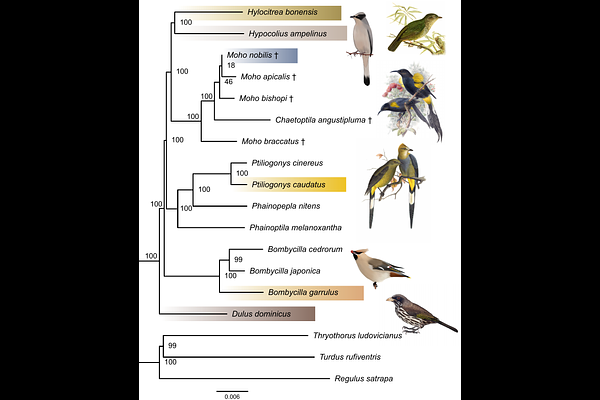The phylogenetic position of the extinct Hawaiian honeyeaters: Overcoming the limitations of antique DNA

The phylogenetic position of the extinct Hawaiian honeyeaters: Overcoming the limitations of antique DNA
Zhao, M.; Kimball, R. T.; Braun, E. L.
AbstractMohoidae, the Hawaiian honeyeaters, are a group of extinct birds that once inhabited the Hawaiian Islands. Their genetic data are only available from historical museum specimens, so it is based on highly fragmented and damaged DNA. Poor sequence recovery in these \"antique\" samples can bias phylogenetic inference which often results in exceptionally long terminal branches in the phylogeny. These long branches can distort estimates of phylogeny, an artifact known as long branch attraction. However, the best way to analyze this data is unclear because these long branches are typically artifactual, reflecting DNA quality. We investigated the position of Mohoidae within the superfamily Bombycilloidea using published alignments of ultraconserved elements (UCEs) and re-assembled UCEs from raw sequencing reads. The uncertainty involves two monotypic families (Hypocoliidae and Hylocitreidae). Re-aligning UCEs using a smaller taxon set closely related to Mohoidae, along with edge trimming and reassembly, eliminated the long branches of Mohoidae and Hypocoliidae (also represented by an antique sample). The sister relationship of these two families in previous studies appears to be artifactual; our new analyses yielded congruent topologies that placed Mohoidae as sister to a clade comprising Hypocoliidae and Hylocitreidae. We also found that different assemblers (SPAdes vs Trinity) yielded sequences with conflicts towards the ends of the UCEs, especially for the antique samples, although this did not alter the topology. Finally, combining the UCEs with legacy data allowed us to produce a strongly supported complete phylogeny of Bombycilloidea the included all extant species as well as the extinct Mohoidae.